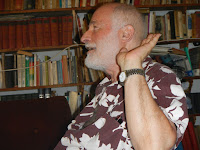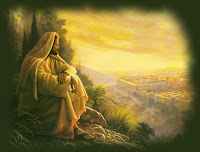
"Come le api producono il miele raccogliendo le essenze delle piante riducendone il succo in una sola qualità, così che le piante non avvertono più la distinzione: io sono il succo di questa pianta o di quella; così tutte queste creature viventi, immergendosi nell'Essere, non hanno la consapevolezza: siamo immerse nell'Essere: Qualunque sia la loro forma, di tigre, di lupo, di verme o di zanzara, quella forma tornano ad essere. Ciò che è infinitamente sottile: ha Quello (l'Essere) come essenza, Quello è la Realtà, l'atman e 'Tu sei Quello'..." (Chandogya Upanisad VI, 9)
Il concetto di spiritualità è una attribuzione di carattere umano. Si dice che solo l’uomo sia in grado di sperimentare coscienza di sé ed intelligenza discriminativa e razionale. Questa capacità possiamo anche definirla “spirito”… Allo stesso tempo siccome non esiste cosa su questa terra e nell’universo, che possa dirsi separata -in quanto il tutto si manifesta nella totalità del “tutto”- e la vita stessa è inscindibile nelle sue varie manifestazioni, manifestando radici comuni in tutte le sue forme, di qualsiasi genere e natura, si può intuire che la caratteristica della “coscienza-intelligenza” sia presente in ogni elemento vivo, che dimostra nascita, crescita e morte, sia pur in diversi gradienti.
Facciamo l’esempio della crescita in “intelligenza e coscienza” come avviene nell’uomo. Cominciando dalla sua formazione in quanto unione di spermatozoo ed ovulo, passando per la sua fase embrionale, alla formazione completa degli organi, alla fuoriuscita dal grembo, all’inizio della sua capacità di apprendimento e discernimento… attraverso vari momenti evolutivi che -pur apparentemente differenti in qualità- rappresentano comunque una crescita del medesimo soggetto.
Se ciò avviene nell’uomo perché non ipotizzare che possa avvenire in ogni altra forma vitale, pur in una scala differenziata e di diversa qualità? Se accettiamo questa premessa come un presupposto di condivisione della stessa “coscienza ed intelligenza”, ecco che improvvisamente possiamo riconoscere in tutto ciò che è vivo la qualità “spirituale”…
Ma ben inteso non in senso religioso… quella è un’assunzione che non compete noi laici. No, riconosciamo lo “spirito” in quanto capacità della vita di esprimere se stessa in forme energetiche dotate di coscienza.. e qui possiamo fermarci…
Poi, dal punto di vista poetico ed emozionale, perché non descrivere la vita di un albero come espressione spirituale della natura? Cosa c’è di male…
Innegabilmente anche un albero è vivo e si esprime attraverso le sue funzioni biologiche e manifesta desideri e repulsioni, come noi umani…
Partendo da questo assioma arriviamo al concetto di "Ecosofia", una forma di pensiero para-spirituale-ecologico elaborata dal filosofo norvegese Arne Naess
"Arne Dekke Eide Næss (Oslo, 27 gennaio 1912 – Oslo, 14 gennaio 2009) è stato un filosofo norvegese. Ha studiato filosofia, matematica ed astronomia all'università di Oslo, alla Sorbona e a Vienna dove frequentò il locale Circolo. Docente di filosofia a Oslo fino al 1969, si è interessato di: storia della filosofia, filosofia della scienza, etica; nutrì particolare interesse per il pensiero di Spinoza e Gandhi. Ha fondato la rivista internazionale di filosofia Inquiry che ha diretto fino al 1975. È stato il primo ad utilizzare il termine ecosofia (od ecologia profonda) il cui concetto è stato ampiamente sviluppato da filosofi come Raimon Panikkar e Félix Guattari." (Wikipedia)
I concetti da Naess propugnati possono facilmente essere ricollegati al pensiero naturalistico, sia in termini prettamente materialistici che spirituali. In passato questa visione olistica è stata anche definita "panteismo". Naess ha approfondito questo concetto, sostenendo l'unitarietà della vita e del substrato sottile che la compenetra, da qui anche l'uso della parola "ecologia profonda" da lui usata per significare lo studio della vita e dell'ambiente sino alle sue più profonde origini e radici.
Il filone dell'ecosofia ha poi trovato sinergie e collegamenti con altre filosofie, o meglio pratiche di vita, naturalistiche e spirituali, come ad esempio la "spiritualità naturale o laica", che assieme all'ecosofia formano una sorta di "unità".
La meraviglia con cui i primi uomini hanno osservato e adorato gli aspetti molteplici della natura, degli animali, degli alberi e dell'habitat, a cui venivano dati nomi, qualità e sembianze divine, il riconoscersi parte integrante di questo insieme, il sapere che nulla può essere separato e che ogni cosa compartecipa ad ogni altra cosa in un afflato panteista, tutto ciò può essere definito ecologia profonda o ecosofia, neologismi inventati da Arne Naesse per descrivere qualcosa che era già, che faceva parte del nostro sentire ancestrale. E' la meraviglia di sé, la coscienza di esistere e di essere consapevoli di esistere, la capacità di comprendere, di sentire emozioni profonde, di riconoscersi in tutto ciò che è, l'intuizione di essere presenti senza ombra di dubbio e di percepire la pienezza del proprio essere in tutto ciò che si manifesta, questo il sentire della spiritualità naturale o laica.
Insomma parlando di ecologia profonda e di spiritualità laica si parla di corpo e di spirito, senza separazione alcuna fra l'uno e l'altro, due aspetti della stessa incredibile magia. Siccome il conosciuto ha bisogno di essere ricordato, conservato e riproposto, tempo dopo tempo, in forme sottili come avviene per la conoscenza filosofica o per le religioni, ed in forme materiali come avviene con il Dna e con il tramando delle arti e della capacità tecniche, ricorriamo alla simbologia archetipale come deposito di memoria e conoscenza.
Diceva il grande saggio non-dualista nostro contemporaneo, Nisargadatta Maharaj: «Noi non possiamo essere altro che una parte integrante della manifestazione totale e del totale funzionamento ed in nessuna maniera possiamo esserne separati». In ciò si coglie una similitudine con la Panarchia che pur essendo un pensiero comparso quasi due secoli prima, è stato dimenticato dalla storia.
Forse non abbiamo nemmeno bisogno di ricorrere alla storia che con le interpretazioni di chi riporta, narra, commenta, fatti e comportamenti umani, non ci fa vivere o rivivere esperienze aderenti alla realtà. Forse ci dobbiamo rivolgere a quel grande laboratorio che è la memoria collettiva. Di fatto, in questo momento possiamo entrare nella storia, possiamo guardare a tutte quelle "anime" presenti oggi nel mondo, che sono rappresentative di realtà che vanno da uno stato che non si discosta molto da quello primordiale a quello che rappresenta la condizione più avanzata della tecnologia.
Questo gioco della natura ci consente un'osservazione diretta di sistemi di aggregazione sociale, culturale ed economica, di interpretarli e di cercare di capire che cosa fare per superare le vecchie e le nuove miserie e di essere attori entusiasti nel progetto di costruzione di un mondo equo, solidale, felice, e quindi con un futuro.
La natura (o la vita) di per se stessa è "non-duale" e quali sono in estrema sintesi i legami tra la spiritualità laica e l'ecologia profonda di Naess?
Nel significato originale della parola ecologia, rispetto alla sua consimile ambientalismo, è già delineata una differenza d'intendimento e pure che l'esatta traduzione di ecologia è studio dell'ambiente. Mentre in ambientalismo si presume il criterio della semplice conservazione. Aggiungendo al termine ecologia l'aggettivo profonda, ecco che si tende ad ampliarne il significato originario, integrandovi il concetto di ulteriore ricerca all'interno della struttura ambientale. Insomma si va a scoprire il substrato e non si osserva solo la superficie, la pelle dell'ambiente.
Lo stesso dicasi per la parola spiritualità e la sua qualificazione laica. In questo caso si cerca di dare una connotazione libera alla spiritualità comunemente intesa come espressione della religione. La spiritualità è l'intelligenza coscienza che pervade la vita, è il suo profumo. Non è assolutamente un risultato della religione, anzi spesso la religione tende a tarpare e a nascondere questa naturale spiritualità presente in tutte le cose.
Da un punto di vista delle espressioni archetipali, la spiritualità laica e l’ecologia profonda affondano il loro esistere nella coscienza. L’uomo si è interrogato sulle forze della natura e sulla vita e questo interrogarsi ha prodotto la spiritualità, l’ecologia profonda è una forma di approfondimento in senso materiale di questa ricerca.
Entrambi gli approcci partono dall’esistente, dal modo di percepire noi stessi e la realtà che ci circonda, il primo è un approccio in senso metafisico mentre il secondo prende in esame il fisico ma non v’è differenza fra i due aspetti, se non nel modo descrittivo.
Nell’ecologia profonda come nella spiritualità naturale si sottintende un quid che impregna le trame della vita. Tale quid è stato descritto come sorgente di tutte le cose, indipendentemente dal chiamarlo spirito o forza vitale. In realtà lo spirito, in quanto coscienza intelligenza, è il modo espressivo, il profumo esistenziale, di ciò che dal punto di vista dell'osservazione empirica dell'ecologia definiamo materia o habitat.
Paolo D’Arpini

Testo inglese:
"As the bees produce honey by collecting the essences of the plants reducing their juice in a single quality, so that the plants no longer feel the distinction: I am the juice of this plant or of that; so all these living creatures, immersing themselves in the Being, they do not have the awareness: we are immersed in the Being: Whatever their form, like a tiger, a wolf, a worm or a mosquito, that form returns to being, what is infinitely subtle: it has That (the Being) as essence, That is Reality, the atman is You are That '... "(Chandogya Upanisad VI, 9)
The concept of spirituality is an attribution of the human nature. It is said that only man is able to experience self-awareness and discriminative and rational intelligence. This ability we can also define as "spirit" ... At the same time as there is no such thing on this earth and in the universe, which can be said to be separate - in that the whole is manifested in the totality of the "whole" - and life itself is inseparable in its various manifestations, manifesting common roots in all its forms, of any kind and nature, one can sense that the characteristic of "consciousness-intelligence" is present in every living element, which demonstrates birth, growth and death, albeit in different gradients .
Let's take the example of growth in "intelligence and conscience" as it happens in man. Beginning with its formation as a union of sperm and egg, passing through its embryonic phase, to the complete formation of the organs, to the exit from the womb, to the beginning of its capacity for learning and discernment ... through various evolutionary moments which may seem different in quality - they still represent a growth of the same subject.
If this happens in man why not hypothesize that it can happen in any other vital form, even in a differentiated and different quality scale? If we accept this premise as a presupposition of sharing the same "conscience and intelligence", then suddenly we can recognize in all that is "spiritual" quality ...
But of course not in a religious sense ... that is an assumption that is not our responsibility as lay people No, we recognize the "spirit" as the capacity of life to express itself in energetic forms with consciousness ... and here we can stop ...
Then, from a poetic and emotional point of view, why not describe the life of a tree as a spiritual expression of nature? What's wrong ...
Undeniably even a tree is alive and is expressed through its biological functions and manifests desires and repulsions, like us humans ...
Starting from this axiom we come to the concept of "Ecosophy", a form of para-spiritual-ecological thought developed by the Norwegian philosopher Arne Naess
"Arne Dekke Eide Næss (Oslo, 27 January 1912 - Oslo, 14 January 2009) was a Norwegian philosopher. He studied philosophy, mathematics and astronomy at the University of Oslo, at the Sorbonne and in Vienna where he attended the local club. in Oslo until 1969, he was interested in: history of philosophy, philosophy of science, ethics, he had a particular interest in the thought of Spinoza and Gandhi He founded the international journal of philosophy Inquiry which he directed until 1975. It was the first to use the term ecosophy (or deep ecology) whose concept has been widely developed by philosophers such as Raimon Panikkar and Félix Guattari. " (Wikipedia)
The concepts proposed by Naess can easily be linked to naturalistic thinking, both in purely materialistic and spiritual terms. In the past this holistic view has also been called "pantheism". Naess has studied this concept in depth, supporting the unity of life and the subtle substrate that permeates it, hence also the use of the word "deep ecology" used by him to signify the study of life and the environment up to its deepest origins and roots.
The strand of ecosophy has then found synergies and connections with other philosophies, or better life practices, naturalistic and spiritual, such as for example "natural or secular spirituality", which together with ecosophy form a sort of "unity".
The wonder with which the first men observed and adored the multiple aspects of nature, animals, trees and habitat, which were given names, qualities and divine appearance, recognizing themselves as an integral part of this whole, knowing that nothing it can be separated and that everything shares in everything else in a pantheist afflatus, all this can be called deep ecology or ecosophy, neologisms invented by Arne Naesse to describe something that was already, that was part of our ancestral feeling. It is the wonder of oneself, the awareness of existing and being aware of existing, the ability to understand, to feel deep emotions, to recognize oneself in all that is, intuition to be present without a shadow of a doubt and to perceive the fullness of one's being in all that is manifested, this is the feeling of natural or secular spirituality.
In short, speaking of deep ecology and secular spirituality we speak of body and spirit, without any separation between one and the other, two aspects of the same incredible magic. Since the known needs to be remembered, preserved and re-proposed, time after time, in subtle forms as happens for philosophical knowledge or for religions, and in material forms as happens with the DNA and with the plotting of the arts and technical skills , we resort to archetypal symbolism as a repository of memory and knowledge.
The great non-dualist sage our contemporary used to say, Nisargadatta Maharaj: "We cannot be anything other than an integral part of total manifestation and total functioning and in no way can we be separated from it". In this we see a similarity with the Panarchy, which despite being a thought that appeared almost two centuries earlier, has been forgotten by history.
Perhaps we do not even need to resort to history which, with the interpretations of those who report, narrate, comment, facts and human behaviors, does not make us live or relive experiences that adhere to reality. Perhaps we must turn to that great laboratory which is the collective memory. In fact, at this moment we can enter into history, we can look at all those "souls" present today in the world, which are representative of realities ranging from a state that does not differ much from the primordial one to that which represents the most advanced condition of technology.
This game of nature allows us to directly observe systems of social, cultural and economic aggregation, to interpret them and to try to understand what to do to overcome the old and new miseries and to be enthusiastic actors in the project of building a world fair, supportive, happy, and therefore with a future.
The nature (or life) of itself is "non-dual" and what are the ties between the secular spirituality and the deep ecology of Naess?
In the original meaning of the word ecology, compared to its similar environmentalism, a difference of understanding has already been outlined and also that the exact translation of ecology is a study of the environment. While in environmentalism the criterion of simple conservation is presumed. Adding to the term ecology the deep adjective, here we tend to expand the original meaning, integrating the concept of further research into the environmental structure. In short, the substrate is discovered and not only the surface, the skin of the environment is observed.
The same applies to the word spirituality and its secular qualification. In this case we try to give a free connotation to spirituality commonly understood as an expression of religion. Spirituality is the intelligence that pervades life, it is its scent. It is absolutely not a result of religion, indeed religion often tends to clip and hide this natural spirituality present in all things.
From the point of view of archetypal expressions, secular spirituality and deep ecology sink their existence into consciousness. Man has asked himself about the forces of nature and life and this questioning has produced spirituality, deep ecology is a form of deepening in a material sense of this research.
Both approaches start from the existing, from the way we perceive ourselves and the reality that surrounds us, the first is an approach in a metaphysical sense while the second examines the physical but there is no difference between the two aspects, if not in the descriptive way. In profound ecology as in natural spirituality a quid is implied that permeates the plots of life. This quid has been described as the source of all things, regardless of calling it spirit or life force. In reality the spirit, as intelligence consciousness, is the expressive way, the existential perfume, of what we define as matter or habitat from the point of view of the empirical observation of ecology.
Paolo D’Arpini












